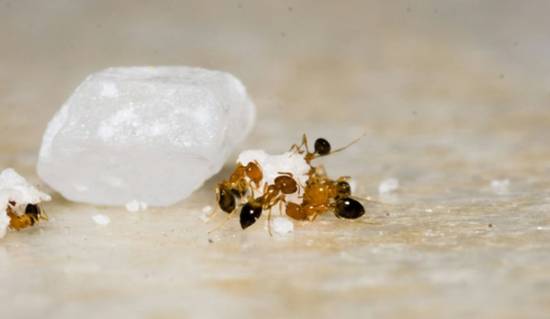
In general UK ants are nothing to worry about, but that doesn’t mean you want them invading your home.
While any problem ants you discover may not be as extensive as the 3,700 mile-wide Argentinian ant super colony (the world’s largest known ant colony) you will still want them gone.
Ants are at their most active from June to September, so there’s a pretty good chance you’ll see them.
Ants are persistent and will invade your home if the conditions are right.
Black Garden Ant (Lasius niger)
Also known as the common black ant, they are about 3-5mm long, and dark brown to black. The black garden ant is typically found in gardens, under stones, and in soil. They are highly social and form large colonies. This ant is generally harmless but they often invade homes in search of primarily sweet foods and can contaminate food sources.
Pharaoh Ant (Monomorium pharaonis)
The pharaoh ant is about 2mm long and yellow-brown with a darker abdomen. They prefer warm, humid environments such as heated buildings and hospitals. Pharaoh ants form large colonies, with multiple queens, making them difficult to control and they forage for a wide range of foods including sweets and proteins.
Pharoah ants are known to carry and spread bacteria, posing health risks, especially in hospitals and food preparation areas.
Red Ant (Myrmica rubra)
Also known as the European fire ant, they are reddish-brown and about 4-5mm long and found in gardens, under stones, and in moist soil. Red ants are aggressive and can deliver a painful sting. Form large colonies and forage for a variety of foods. Can be a nuisance because they form large colonies, their painful sting and potential to infest homes.
Yellow Meadow Ant (Lasius flavus)
Yellow meadow ants are yellow to light brown and about 2-4mm long. They are commonly found in grassy areas, meadows, and gardens. Nests are often indicated by small mounds of soil.
While they rarely enter homes they do feed on aphids' honeydew, so if you have a plant with aphids they may be attracted. Yellow meadow ants are generally harmless to humans and pets, but their mounds can disrupt lawns and gardens.
Roger's Ant (Hypoponera punctatissima)
These are about 2.5-3.5mm long, and yellow to light brown. They prefer damp environments, so are often found in greenhouses, under stones, and in decaying wood looking for small insects. They are generally not a major pest, but might be found indoors where the environment is humid.
Managing an ant infestation can be as simple as taking a few preventative measures. However, ants are social and a few single ants can soon mean a colony. If in any doubt call a specialist in ant control to help you deal with any infestation and prevent it coming back.
Ants will come indoors once they find a good source of food. They also usually enter homes when they are looking for better conditions, moisture, warmth and shelter. When a few ants find their way into your home, word normally spreads very quickly, and you could soon end up with an infestation to deal with.
To start it’s best to properly identify the ant species to determine the best control methods and understand their specific behaviours and habitats. This is where a specialist can really help.
But in terms of preventative measures, wipe down surfaces, sweep floors, and clean up spills immediately to eliminate food sources.
Empty bins regularly, or at least keep the lids closed so ants can’t get inside.
Clean up food crumbs and store food in airtight containers to reduce the ants’ access to food sources.
Find their entry point. They could be coming through a door that you leave open during the day, a window with a broken seal or through a crack in your home’s structure. Seal any holes or gaps around windows, doors, and foundations to prevent ants from entering. They are small and don’t need much space to get in.
Keep plants healthy and free of aphids and other pests that produce honeydew. Repair any leaky taps or pipes to reduce water sources.
Ant baits and traps can work in areas where ants are frequently seen. Baits allow worker ants to carry poison back to the nest, so can be especially effective. Once the ants have taken it back to their nest, it can take several days to fully eliminate the colony. However, for persistent or severe infestations, consider hiring a professional pest control service. They can provide targeted treatments and advise on long-term prevention.
Ant invasions are a common issue that can be frustrating.
Ants typically invade homes in search of food, water, and shelter. Even the smallest crumbs, spills, or leaks can attract them. Additionally, ants are attracted to the warmth and safety that homes provide, especially during colder months.
Keeping things clean, properly storing food, sealing entry points, and addressing moisture issues, you can significantly reduce the likelihood of ant invasions. Regular inspections will help keep your home ant-free, ensuring a more comfortable and pest-free living environment. Addressing these factors is the best way to prevent these unwelcome guests from making your home theirs.
If you’re worried about an ant infestation, or any other pest, call our pest control specialists on 0330 108 4111.